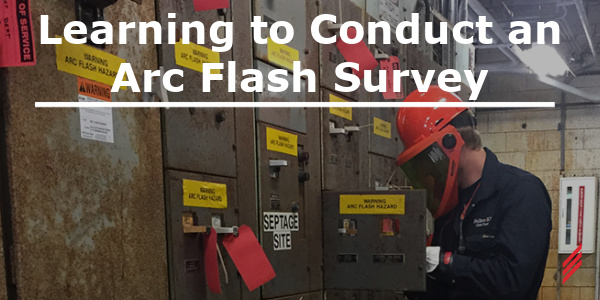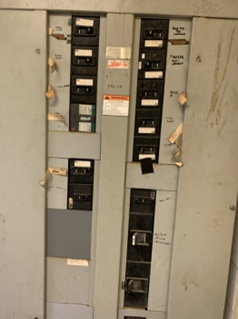Learning to Conduct an Arc Flash Survey
by Steven Skoll on Jan 25, 2024 10:30:00 AM

Graduating from college, I came to the sudden realization: I had no idea how the real-world works. Very little was provided to prepare me for life outside college, whether it be dealing with taxes, purchasing my own car, or how to find a job. The only thing I had was the baseline knowledge that a bachelor’s degree in electrical engineering provides. So, when I started at Hallam-ICS and was expected to be entering electrical rooms and, one day, opening electrical equipment to gather protective device and conduit information, I’ll admit I was intimidated.
After receiving theoretical electrical safety training, I went on my first survey trip with my coworker, Jordan Powell. I walked into the electrical room, with the main switchboard for the site, humming with energy, and understood just how little I knew about real electrical systems. I had barely interacted with the panel of breakers for my house growing up, so I was way over my head. I knew that I had a lot of learning to do. I remember one of my first questions to Jordan was what the difference was between a panel and a busbar.
Luckily, Jordan understood that my college degree did not equate to a full understanding in electrical systems and made it clear that my job was to familiarize myself with what I was looking at: try to recognize the flow of current, what a main breaker was versus the branch breakers feeding the rest of the site. The most important thing to take note of with every piece of electrical equipment is the dangers of the electrical system; how to find and interpret important electrical safety information provided by the warning labels plastered on pieces of equipment, and keeping note of anything that could potentially be a hazard.
I would be lying if I said I understood what was going on during that first site visit. After leaving the main electric room, we roamed around the site, finding all the electrical panels throughout various buildings and gathering information on their main breakers and branch breakers, and finally connecting all the panels together on our hand-drawn one-lines.
It felt as though I was a kid at the zoo; completely mesmerized by an actual electrical system, all the while Jordan was gliding through the survey with ease and comfort, quickly understanding how incoming power was going into the main switchboard, and subsequently flowing to all the sub-panels located throughout the site. By the end of it, I had a one-line drawing, complete with circuit breaker and conduit information, and more questions than I ever would have imagined I could have. However, I realized that I wanted to know more, and wanted to be capable of what Jordan was doing essentially by himself during this last survey trip.
And so, I started going out into the field, more and more, and became more comfortable with everything I saw during my first survey. But this was only the first step in the surveying skills I needed; I needed to start opening the panels.
Unlike creating one-lines, the process of opening electrical equipment is something you cannot fully prepare for; in order to get good at opening equipment, I needed to gain experience. This was a whole new ballgame. I may have been to a lot of different sites and seen many different types of equipment, but now I must learn how to safely remove the screws of the dead front for the various forms of panels that appear throughout electrical systems.
Opening panels was much harder than I thought. My coworkers always made it look so easy. In trying to open these panels, I once again found another intimidating part of the job that I was not expecting to find.
Let’s start with the various types of panels, and there are a lot. The panels differ depending on several factors: the brand, the manufactured year, the size, and the type of equipment they are feeding. You know you’re lucky when you find some door-in-door electrical panels, and you know it’s going to be an annoying time when you find the ”Jenga” puzzle of a panel shown below, where you must remove every piece in a specific order to properly see the wiring behind the dead front.
And so, I began my journey of learning to open electrical equipment. I was given a series of training, warnings, and things to watch out for from Jordan before getting my hands on the various pieces of equipment at sites. While I was scared (and still am scared) to open the electrical equipment, I think it gives me the proper amount of respect that this dangerous situation deserves.
During the beginning, I was slowly taking off dead fronts, getting used to the weight of the various sizes and getting an understanding of where I can put my hands safely. My coworkers provided me with a few more tips and tricks for opening different kinds of equipment, and I quickly got the hang of opening. Of course, I know there are a lot of types of equipment I have yet to encounter (or open), and so I have a lot to learn to make working with electrical equipment seem easy, like my coworkers do.
So, the moral of the story? When being introduced to a new experience, no matter how intimidating it may be, I have to know that I can do it. I need to be patient with myself and the process of learning.
About the author
Steven graduated from North Carolina State University in 2020 with a bachelor’s degree in electrical engineering. He spent a year after graduating volunteering with a non-profit organization dedicated to spreading renewable energy systems to rural locations in Uganda. In the summer of 2021, Steven joined the Arc Flash team in the North Carolina office of Hallam-ICS. Outside of work, Steven enjoys playing video games, rock wall climbing, and meeting new people.
Read My Hallam Story
About Hallam-ICS
Hallam-ICS is an engineering and automation company that designs MEP systems for facilities and plants, engineers control and automation solutions, and ensures safety and regulatory compliance through arc flash studies, commissioning, and validation. Our offices are located in Massachusetts, Connecticut, New York, Vermont and North Carolina, Texas and Florida and our projects take us world-wide.
You May Also Like
These Related Stories

Basic Hazardous Gas Monitoring: Assessment and Selection of Ideal Gas Monitoring Technologies

Engineering Success: What School Doesn’t Teach You About the Industry


No Comments Yet
Let us know what you think